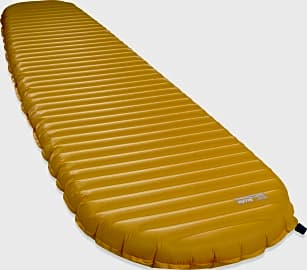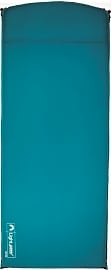The 9 Best Camping Pads

This wiki has been updated 38 times since it was first published in April of 2015. Whether you need your rest so you are ready for a hike the next day or to ensure you don’t snap at everyone around you, you’re going to want a camping pad in order to get the best night’s sleep possible when in the great outdoors. They vary in style, from inflatable to foam, and in R-value, which indicates how insulating they are, with the higher values being more suitable for cold weather. When users buy our independently chosen editorial selections, we may earn commissions to help fund the Wiki.
Editor's Notes
July 16, 2021:
This round of updates saw just a few minor updates that involved searching out new, upgraded models to replace their discontinued counterparts. This is actually a good thing, as it means manufacturers are taking steps to increase durability and effectiveness. The Big Agnes Q Core SLX is one of those, and the newly recommended model is especially light and features wide outer sections to keep you from rolling off in the night. The Sea to Summit Comfort Light is another new, high-end addition to the list, and it's a great alternative to the no-longer-available Comfort Plus. The remainder of our selections are unchanged, and we still like the Therm-a-Rest ProLite Plus as the most cost-effective for 3-season camping.
July 26, 2020:
It remains tough to beat the Therm-a-Rest ProLite Plus, which packs down small but is still big on comfort, no matter which size you choose. But we've opted to remove the UberLite, also from Therm-a-Rest. True, it is one of the lightest pads around, but this also means it can't take as much abuse as some, since "featherlight" materials generally lose some durability along with the weight. For this reason, the OutdoorsmanLab Ultralight or the Big Agnes Air Core Ultra might make better choices for all but the most hardcore ultralight enthusiasts, even though these pads are a few ounces heavier than the UberLite.
If shaving off every last ounce isn't as much of a concern, the Klymit Static V Luxe and the Lightspeed Outdoors XL FlexForm are still good options. The Klymit model comes in an extra-wide version, a big plus for those who toss and turn a lot, while the FlexForm is exceptionally warm, with a pillow built right in. The valves found on the latter are not the most durable, however, so plan to treat this one carefully when you inflate and deflate it.
And speaking of inflation, we've opted to add the Exped SynMat HL. Not only is it light and tapered to fit in both your hiking backpack and one-person tent, but it comes with a stuff sack that doubles as a pump. This may not sound like much, but it keeps your moist breath out of the pad and stops you from blowing and blowing into a valve when you're tired and just want to rest.
April 11, 2019:
Hiking should be a pleasant experience, and nothing can get in the way of that like a poor night's sleep. It's important to have a good sleeping pad, whether you're deep in the backcountry or just at a campground with friends and family. If you're not going to be carrying it far and your budget is extremely tight, the Therm-a-Rest RidgeRest Classic is a good choice, though it's not nearly as comfortable as inflatable options. It is, however, much more durable, because of course it cannot develop an air leak. Klymit's insulated Static V is a good choice for cold weather camping, and the Sea to Summit Comfort Plus can handle reasonably cold temperatures as well. It's hard to top the Lightspeed Outdoors XL FlexForm, though, with its R value of 9.6, which promises a warm night -- provided you have a good sleeping bag. On the other end of the spectrum, the newest Klymit Static V2 is almost certainly the best affordable warm-weather option, and is great for ultralight enthusiasts on a moderate budget. The OutdoorsmanLab Ultralight is also a good choice there, and we highly recommend almost anything from Colorado's Big Agnes. If you've got a little bit more to spend, the NeoAir UberLite is just about the lightest one on the market, and it's quite comfortable, to boot. And the Therm-a-Rest ProLite Plus is often hailed as the best around; it's not uncommon to see it on pack lists for frequent PCT through-hikers.
Special Honors
Cabela's Instinct You won't be likely to roll off the thoughtfully-designed Cabela's Instinct, since it sports raised chambers along the outside to keep you comfortably in place. But don't worry, these don't make it bulky, as it rolls into a compact, portable package in a flash. cabelas.com
L.L.Bean Camp Futon Double The L.L.Bean Camp Futon Double is 52 inches wide, which means there's enough space for you and a loved one to share. This size does make it heavier than many at about 8.5 pounds, but it comes with a stuff sack to ensure that it's relatively easy to transport, especially if you're car camping. llbean.com
The Camper and the Pea
These were basically the branches of different evergreens laid on the floor of the cave that acted as a kind of mosquito repellent, among other things.
Remember The Princess and the Pea? It's that old story about a young princess who's found outside the city during a rainstorm, and is tricked into supporting her claim to royalty by having to sleep on a stack of mattresses with a pea underneath them.
It's a biting commentary about class and sensitivity, and it ought to insult over-sensitive campers to be associated with it.
Pads for sleeping in the open elements have evolved swiftly in the past half century or so, as advancements in materials have increased tensile strength and decreased both size and weight of available mats.
We've certainly come a long way since the 77,000 year old sleeping mats they found in South Africa a few years ago. These were basically the branches of different evergreens laid on the floor of the cave that acted as a kind of mosquito repellent, among other things. Don't let the bedbugs bite, right?
At first glance, it may seem like the purpose of these modern camping pads is to increase the sleeper's comfort against hard surfaces, from the rockiest natural ground to the hardest sheet of ice to the smallest of peas. In truth, sleeping comfort is an oft-cited criticism of a variety of these products, but their reason d'etre is more thermal regulation than imperial comfort.
That said, some of the options above imply that the regulation of a camper's spinal alignment and next-day soreness are becoming as important in the marketplace as not dying of hypothermia.
I guess the reality is that if you're camping in comfortable areas, or even RVing, it isn't likely that you're putting yourself in a position to freeze. So, sure, other comforts might come into question.
This, That, or the Other?
There are certainly as many types of sleeping pads as there are types of campers, and choosing what's right for you will require that you ask yourself some questions.
Maybe you need something rated for superior thermal control, something thicker and cushier.
How do you sleep? Are you a light sleeper, awoken by the subtlest change in temperature or softness beneath you? Maybe you need something rated for superior thermal control, something thicker and cushier.
How much ground are you covering? Planning to hike 30 miles today? You're probably going to want to prioritize packing size and weight over comfort. Let's face it: at the end of a day like that, you'll be able to sleep comfortably standing up, hanging upside down, or even underwater!
Where are you? Headed to Mt. Doom? Or are you RVing to the park down the street? If you know you're going to have ready access to civilization, and your camping style is more for the backyard than the badlands, you might be able to get away with spending a little less on your setup.
A Few Words About R-Rating
No, I'm not invoking the Motion Picture Association of America here. I don't think there's a sleeping pad on the market that's recommended for campers 17 years of age or older unless accompanied by a parent or guardian. I'm talking about insulation, that sweet, fiberglass cotton candy that some of us were shocked to discover as children was neither sweet nor cotton candy, but definitely fiberglass.
The R-rating, or R-value, is a way to measure the effectiveness of a material's insulating properties. That's how well it maintains the temperature difference on either side of the material.
Now, some manufacturers might not be too keen on letting you know what their R-rating is, especially if it doesn't measure up to the competition.
Imagine you're all comfy and cozy in your sleeping bag, with all that body heat melting away the frost from your bones, when–all of a sudden–every bit of that heat dissipates into the cold ground. You see, that old second law in thermodynamics can make cold weather camping all kinds of crummy, as the energy from the hotter areas (a.k.a. where you're desperately trying to sleep) transfers toward the colder areas (a.k.a. all that ridiculous nature out there).
This is where insulation comes in, and the manufacturers of camping pads are always competing for advantages in R-value.
Now, some manufacturers might not be too keen on letting you know what their R-rating is, especially if it doesn't measure up to the competition. Thankfully, that information has been consolidated here, so you don't have to go hunting.
Of course, if you're a camper who only seeks the wild during the more comfortable months of the year, you're probably going to be more concerned with size, weight, and comfort than insulation, but it's good information to have if it tips the scales toward one pad or another.














